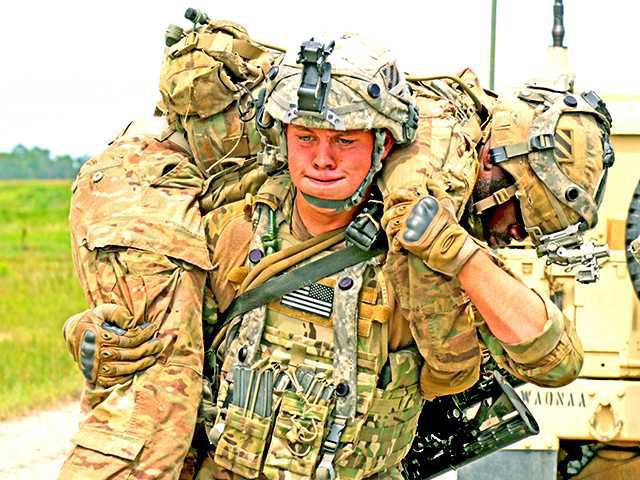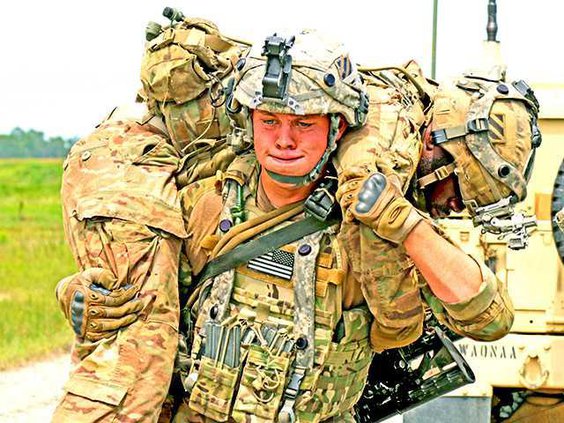An Apache helicopter from the 3rd Infantry Division’s 3rd Combat Aviation Brigade interrupted the early afternoon stillness Sept. 1 on Fort Stewart’s Red Cloud Range Golf, circling high above.
The lone helicopter set in motion another "iteration" of the 1st Armored Brigade Combat Team’s CALFEX, or combined live fire exercise.
The exercise, which followed others like it earlier in the week, also came after months of training at the platoon, company, battery, battalion and brigade level.
All of it was preparation for the 1ABCT’s upcoming rotation to the National Training Center at Fort Irwin, Calif.
The exercise, orchestrated and almost ballet-like, included rockets fired by the Apache, which acted as an aerial lookout, to the thump of rounds fired by Alpha Battery, 1st Battalion, 41st Field Artillery Regiment. Soon, tanks from Alpha Company, 1-64 Armor rumbled quickly down a gravel road and pulled into fighting positions, their turrets moving back and forth until they found their target and fired.
The rehearsal for NTC continued as the first tanks to fire reversed out of fighting positions and charged forward as other tanks came in behind.
Engineers with the 10th Engineer Battalion in a modified Abrams tank fired a mine clearing line charge, or MCLIC, and soon infantry soldiers dismounting from Bradley Fighting Vehicles moved in to clear trenches.
Maj. Peter Bogart, the 1ABCT’s public affairs officer, called it the culminating training event prior to the rotation.
"The CALFEX integrates all of the combat power an armored brigade combat team brings to a fight," he said. "To include artillery and engineer support, while forcing the company to mass those effects on an enemy at the right time and place."
One of the men behind what took place is Capt. Matthew Ropelewski, the 1st Brigade’s planning officer, who summoned numbers from his head as he stood outside the range tower.
Among those numbers: the 10 tanks from Alpha Company had a basic load of 18 rounds each, and the company’s four Bradley Fighting Vehicles each carried 100 25-millimeter rounds. Add the shells fired by four 155-millimeter Paladins and the Apache’s 10 2.7-inch rockets, and a lot of ordnance went downrange during the exercise. All in about an hour and some change.
As the firing continued, Sgt. Richard Ellis was among the soldiers waiting with their equipment in the "bullpen," a fenced-in concrete parking lot filled with tanks and Bradleys.
Ellis, from Detroit, has been in the Army five years and is a tank crewmember and gunner.
He said the CALFEX is a way to put together months of training that began almost as soon as he arrived at Fort Stewart from his previous assignment at Fort Riley, Kan.
That was in June.
"This started as soon as I got here," Ellis said, noting he thought his unit fared well as it worked its way through various "tables," or training, to CALFEX.
Ellis said he wanted to join the Army out of high school but his mother talked him out of it. He said once he had a child, he knew he had to do something.
"I knew I had to step up to the plate, because then it’s not just about you anymore," Ellis said.
As for how long he might serve, the sergeant said he’s not sure.
"Until God opens up another door this is where I’ll be, and I’m not done having fun yet," Ellis said.
Also in the bullpen was Pvt. First Class Curtis Rowan, a 19-year-old combat engineer from Salisbury, Maryland. Rowan, who enlisted right out of high school and just finished the first year of his three-year enlistment, said his job as an engineer in Bravo Company, 10th Engineer Battalion, is to pave the way for the infantry and armor units to move forward and do their job.
"We’re here to make sure it’s clear of anything that might slow down, hinder or stop the troops from going through," Rowan said. "We get rid of the stuff that might be in their way. This training really gives everyone a better idea of what they’re supposed to be doing."
A Redskins fan, Rowan said he’s already been on one deployment and is already thinking he’ll make the Army a career.
"I get to do so much. I could go around the world in the Army," he said. "I’ve gotten to come to Georgia."

